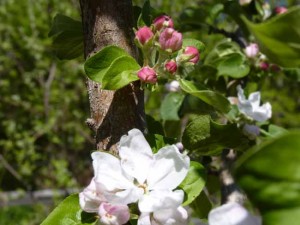Lughnasa Waxing Back to School Moon
It’s been a wet, cool few days. The Apiguard I picked up last night only works above 60 degrees and 70 is better. It recommends chemical resistant gloves. I’m using this on two colonies, the parent and the divide. I tested the divide and its high, putting the colonies winter survival at risk, though I did not test the parent since the divide began with a hive box full of parent colony bees, it seems reasonable to assume it has a high mite count, too. I don’t like using the medication, but the UofM, which shares my bias toward Integrated Pest Management and leans against treating recommends it. I did count my mites, too, so I know the divide has a high mite count. The package colony, which had only 1 mite all together, I will not treat.
The fumigilin-B treats nosema. In this case the only way to reliably test requires a 400+ microscope, an expensive counter and a bunch of dead bees beat up in a mortar and pestle. The U, again, recommends treatment this year in particular so I’m following their advice. Nosema and varroa mites are two of the culprits in colony collapse disorder and often combine to cause the winter loss of a colony.
Integrated pest management for mites and nosema includes using Minnesota hygienic queens, which I have done, and can include use of a drone frame which attracts mites because drones take longer to pupate. When the drone frame has capped brood cells, the beekeeper removes and freezes it, killing the mites and the drones. This reduces the overall mite load.
Integrated Pest Management (IPM) has been around for a while. It’s sort of a middle ground between all organic and contemporary agriculture/horticulture/apiculture techniques. The idea is to put any chemical treatments as last resorts, utilizing first techniques that either directly mimic nature or are supportive to it. In gardening, for example, companion planting qualifies. So does crop rotation. So does soil improvement. So does hand picking insects and pruning out diseased branches or plants. Another involves acknowledging that some level of disease and infestation is a normal part of the natural world. The problem comes when the level begins to interfere with the plant or animals productive ability or its ability to, say, survive a Minnesota winter in our case.
In apiculture it involves, in addition to what I’ve already mentioned, culling 20% or so of your woodenware as it reaches 5 years of age. This reduces nosema because the nosema organism lays down spores that can last as long as 75 years. Another technique involves making sure your colonies have adequate food supplies for the winter. A colony that struggles for food in early spring has much higher susceptibility to disease.
I use IPM in our perennial flower beds, our vegetable garden and now in the Artemis Hives. I’ve not started in the orchard yet because fruit trees are still a mystery to me. Gotta resolve that over the winter.

 damage and as long as I can I’ll follow pinch and destroy. After that, I think, right now anyway, that I’ll go with Gary Reuter, the bee rangler for Marla Spivak. I’ll just put up with wormy apples. This is partly out of regard for the bees who have enough pressure of them and they don’t need an added pesticide load from our orchard, but it’s more out of a commitment to no pesticides, grow strong plants and let them fend for themselves. It’s worked reasonably well for me so far.
damage and as long as I can I’ll follow pinch and destroy. After that, I think, right now anyway, that I’ll go with Gary Reuter, the bee rangler for Marla Spivak. I’ll just put up with wormy apples. This is partly out of regard for the bees who have enough pressure of them and they don’t need an added pesticide load from our orchard, but it’s more out of a commitment to no pesticides, grow strong plants and let them fend for themselves. It’s worked reasonably well for me so far.
 earth, a bit yellow at the top, then light green, then a darker green. Soon there should be other bulbs breaking through including some I’d forgotten I planted in the orchard.
earth, a bit yellow at the top, then light green, then a darker green. Soon there should be other bulbs breaking through including some I’d forgotten I planted in the orchard.







